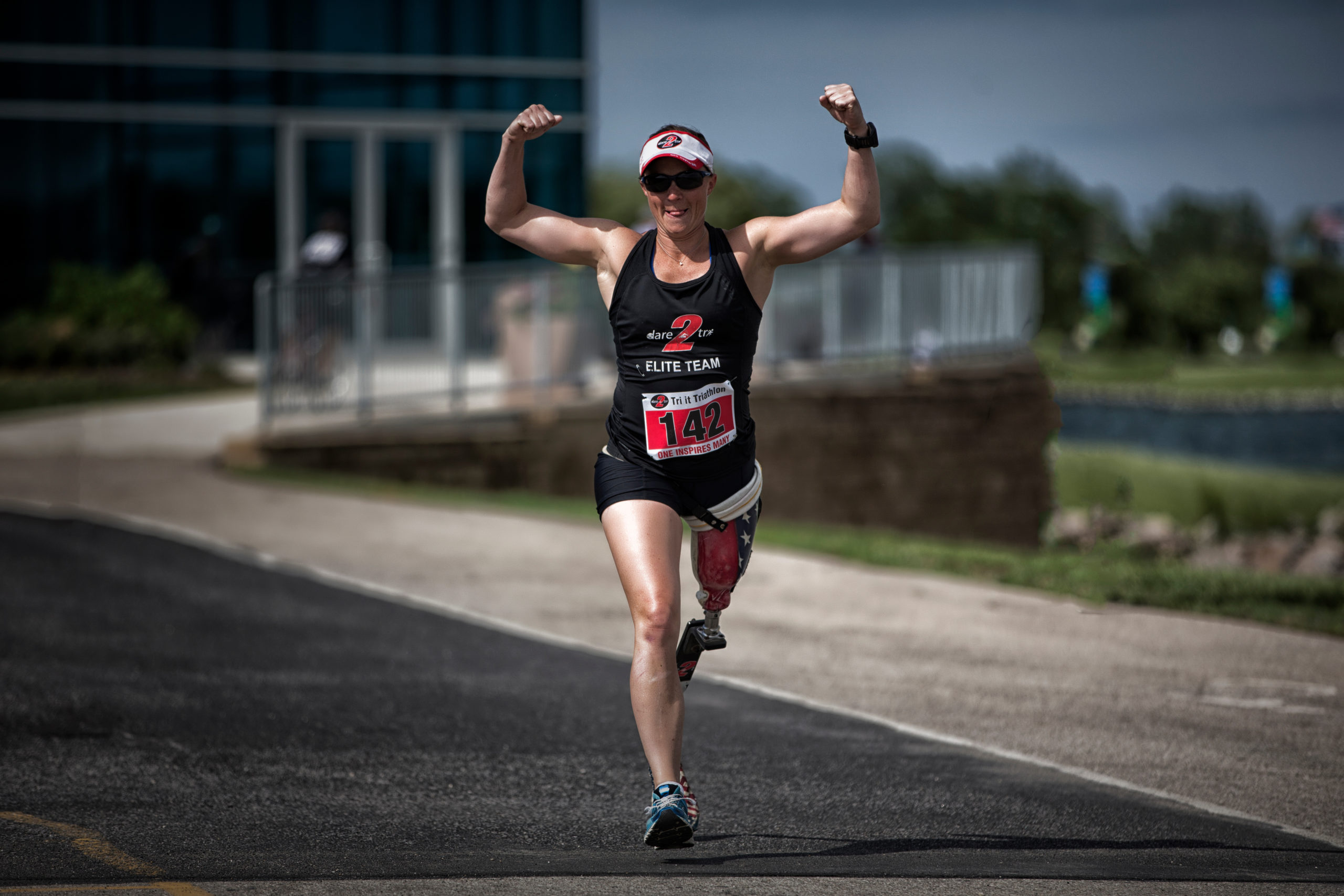
Running/Wheelchair Racing
Getting Started
Start Slow to Go Fast
Just because you have never run farther than the bus stop, is not a reason to ignore the pleasures of recreational and competitive running. The sport provides many benefits. Besides improving overall health, cholesterol levels, and lung function, running is a confidence booster, a stress reliever, and a depression buster.
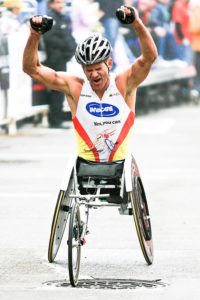 Having a disability, whether its amputation, paralysis, or vision loss, doesn’t mean you can’t join the thousands of others who find the sport a winning choice.
Having a disability, whether its amputation, paralysis, or vision loss, doesn’t mean you can’t join the thousands of others who find the sport a winning choice.
Keri Serota, executive director of Dare2Tri, a Move United chapter that helps athletes with disabilities train for triathlons, offers some advice for the beginner and for those who want to get to a higher level of competition.
If you’ve never run before, Serota suggests starting out with small, attainable running goals before undertaking a half marathon or full marathon.
“Set a small goal for yourself such as a 5K. Depending on how in- or out-of-shape you are, I would say somebody could train for a 5K in 8 to 12 weeks,” she said.
“If you haven’t done a lot of running, start with a run/walk program. For example, run for two minutes, walk for one minute, run for two, walk for one. You are breaking it down to small achievable goals. That’s important because if you set an unrealistic goal and don’t meet it, you will feel frustrated, and then it’s common to give up the program. You want to ensure you have success by setting realistic and small attainable goals, find success with that, and then move on to the next goal,” she said.
A beginner should also go for time instead of distance. Instead of setting your goal on a certain mileage, it’s more effective to increase time. If you’ve worked up to running 15 minutes, set a goal for 30.
Running in Proper Form
Brian Hoddle, a teacher and internationally known track and field coach, including Head Coach of the 2004 USA Paralympic Track and Field team in Athens, states that the most important thing for a runner to have is good body balance. “If a prosthetic limb is not designed correctly, the person is going to have problems all the way up and down the body. It doesn’t matter what workout I give you as an amputee, if your body is not aligned, then you will be hurting all the time, and running is not going to be a lot of fun. Often times you’ll see problems crop up in the SI area.
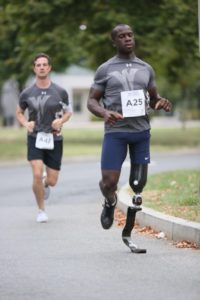 “The second important thing is joint range of motion (JROM) in the shoulder girdle and the hip girdle. If you are standing and you have your hand on the wall and I have you kick leg forward and bring it back – how much of a JROM do you have in your hip? Then I’ll have the athlete face the wall and do leg swings back and forth. Is the JROM the same on both sides of the body or do you have one side or one hip area that is locking up? That causes a lot of problems and I see this with amputees as well as NFL players. The solution is you have to work on it. In the USA, we are fixated on static stretching; that’s not going to solve the issue. The issue is you have to work on JROM through specific exercises.
“The second important thing is joint range of motion (JROM) in the shoulder girdle and the hip girdle. If you are standing and you have your hand on the wall and I have you kick leg forward and bring it back – how much of a JROM do you have in your hip? Then I’ll have the athlete face the wall and do leg swings back and forth. Is the JROM the same on both sides of the body or do you have one side or one hip area that is locking up? That causes a lot of problems and I see this with amputees as well as NFL players. The solution is you have to work on it. In the USA, we are fixated on static stretching; that’s not going to solve the issue. The issue is you have to work on JROM through specific exercises.
“Third is the mental aspect and that is huge whether you are an able-bodied runner or a runner with disabilities. Because it is so interconnected with the physical, if you don’t have your mental house in order, it’s hard to be successful,” he said.
Hoddle uses five words for success: vision, focus, persistence, discipline, and commitment. “Any aspect of your life, even in the business world, you can apply those principles. Athletes today may not have the upbringing or the coach that taught those skills, so it’s something that really needs to be addressed and not taken for granted,” he said.
When it comes to training, Hoddle emphasizes quality vs quantity. “Whatever the workout is, there needs to be a reason for it, and if you can’t figure out a reason for it, you shouldn’t be doing it. Secondly, you get out and get the job done and move on. Time is valuable and precious to people and more isn’t better.”
“I’m a firm believer in time management. If you don’t practice it, you won’t survive,” he said. “If you are a Paralympic athlete, are you going to squeeze an hour and a half practice in or are you going to block a time that is set, so that you are totally focused and ready for a quality practice session. If you fail to plan, you’ll plan to fail. Even for a recreational runner, are you going to go out and squeeze in your run or are you going to say, hey this is important for my health and it’s going to be a priority. I am going to set aside FOCUSED time. So set a 24-hour plan in place (86,400 seconds in a day) that will structure your life, like brushing your teeth, showering, eating breakfast, and training. I think that is really important.”
When running, Hoddle said the foot needs to be dorsi-flexed. “You want to cock the toe up and muscles need to fire sequentially. Muscle A needs to fire to muscle B, then muscle C. If you aren’t firing muscles sequentially when you are running, you are setting up a recipe for injuries.”
Find a Program Near You
Can’t find a program near you? Search the Paralympic Club directory. Also, make sure to check with your local parks and recreation department as well as local YMCAs to see what types of programs they offer.
Equipment and Adaptations
Prosthesis
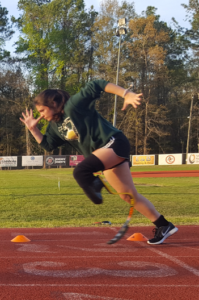 Those who participate in the sport regularly may want to look into investing in a sport or running prosthesis to help minimize wear and tear.
Those who participate in the sport regularly may want to look into investing in a sport or running prosthesis to help minimize wear and tear.
Racing Chairs
Wheelchair users who want to begin a running program may want to explore the availability of a racing chair in their community or contact a DSUSA chapter or another adaptive sports program that has chairs available for individuals to try and practice with.
Serota said a racing chair isn’t required to do a run. “You don’t necessarily need a racing chair just to get involved in the sport and get moving. A wheelchair user can start in an everyday chair or a sports chair like a basketball chair or tennis chair. Athletes have done half marathons in a sports chair,” she said.
Running Guides
For an athlete who is visually-impaired and might need a guide to run with them, Serota recommends reaching out to local running groups. “Stores that sell running shoes and apparel are a good place to start. Approach the group and ask if someone will run with you, say at a 12 minute pace, or whatever your pace is,” she said. “Explain to them what your specific needs are and how you like to be guided. It’s not difficult for a guide to learn and it’s generally a positive experience for both the guide and the runner.”
Adaptive Running Equipment Suppliers
Training Programs
Training for Distance
If you are training for a particular distance, a runner will want a more structured plan and program to build up endurance and mileage.
A plan that backs up from the day of the race is suggested. Figure out what your current level of fitness is now and how many weeks it would take to get to where you can comfortably and safely run whatever distance the goal is.
“People need to be realistic to how many days they want to commit to running,” she said. “Those who are running four or five days per week will have one type of training program, which will look different than someone who has only two or three days per week to train.
“The standard thought is somebody who can run six miles can follow a marathon training program that is about 16 weeks long for comfortable completion of a marathon.”
Supplementary Workouts
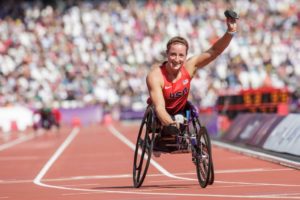 While many runners only want to be able to finish the race – and that is an accomplishment – there are others who always want to better their times. Speed work then is essential.
While many runners only want to be able to finish the race – and that is an accomplishment – there are others who always want to better their times. Speed work then is essential.
Serota explained that speed work is running shorter distances, but picking up on speed using a track or a half-mile repeat on a running path.
For someone who prefers to work on their running alone, there are many resources online that can help with training outlines, which can be found on Dare2Tri’s website. But others may want a coach who will watch their form and technique.
“The training plan including miles per week, speed, and how many times a week is appropriate for both able-bodied and disabled, but what people need coaching for is the body mechanics,” she said. “Somebody who is doing wheelchair racing for the first time is definitely going to want to work with a coach who will give them stroke mechanics , technique and body position.
To find a coach, work through a DSUSA chapter network. They may have a coach, refer you to a coach, or team you with a mentor athlete. U.S. Paralympics has similar chapter networks.
Another source may be your physical therapist, occupational therapist or your prosthetic practitioner. They have an understanding of your disability and there may be a runner in the office who might be able to help and give pointers.
Strength and core training is needed too. “We work with a lot of above the knee amputees who run on a prosthetic leg without a knee joint. That puts a lot of strain on the hip and low back, so we make sure we do a lot of core work to avoid injury and prepare their bodies.” Serota said.
Preparing for a Marathon
When preparing for a marathon, you will need to taper off the training in the two or three weeks prior. “You are doing less mileage closer to race day because you want your body to recover and you want it to feel good on race day,” Serota said.
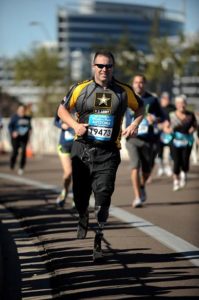 “Another important factor I stress is doing a dress rehearsal. Never eat anything new or wear anything new the day of the race. On one of your last runs before the race, wear what you are going to wear for the race, eat what you will eat that morning, take whatever supplements you will be taking on race day. Try it all in a race simulated situation so you know what will work.
“Another important factor I stress is doing a dress rehearsal. Never eat anything new or wear anything new the day of the race. On one of your last runs before the race, wear what you are going to wear for the race, eat what you will eat that morning, take whatever supplements you will be taking on race day. Try it all in a race simulated situation so you know what will work.
Mental preparation also comes into play. “When training, there will be days when you are hurting or days when you are not feeling your best; those are the days most important to get your runs in because on race day it might be cold or it might be raining, you might not feel well, and that is where the mental toughness comes in.
“If you follow a training plan you will be physically prepared come race day. You have put in the work and are ready, now it comes down to how mentally tough you are. The mental stuff can make or break your day. Stay positive and enjoy it. Know you have put in the work and are ready to cross that finish line.” Serota said.
Set Realistic Goals
“Be realistic about time,” she said. “If you don’t have the time to do the long runs, then maybe now is not the time to do a marathon. Choose a shorter distance so you can do it, complete it, and feel good about it.
“The most important thing is setting realistic goals and achievable goals. If your goal is too big or unrealistic, you will get discouraged and not want to continue. Set small achievable, realistic goals, meet them, feel successful and move on.”
From Casual to Competitive
Tips for Training Beyond the 5K
Hoodle provides great pointers for anyone who is looking into becoming serious about racing and transitioning to racing competitively.
- Get a coach who is knowledgeable, who is a tier up in the coaching level.
- Sign up for runs that have more intense competition.
- Invest the time. An elite runner will be running far more than the recreational runner.
- Be active five days a week and add swimming, biking, weight lifting, or an elliptical trainer, to your fitness routine. Seek out a professional who can give you sound advice on what the best activity is for you.
- Don’t over train. “Proper sleep, good nutrition, and being relaxed, those things are just as critical as the workout,” he said. “You can do great workouts, but if you are only getting four hours of sleep a night or you are stressed out, then it’s not going to work out for you.”
- As you get closer to race day, don’t start changing your training. Be consistent in your good nutrition, sleep and continue to work on your mental part.
For more information on training or coaching, contact Bryan Hoddle at bhoddle@usa.net.
Adaptive Divisions
The following races include one or more of the following divisions: push rim wheelchair and/or hand-cycle, visually impaired, and mobility impaired.
- Boston Marathon
- Chicago Marathon
- Detroit Marathon
- Disney Marathon
- Los Angeles Marathon
- Marine Corps Marathon
- Miami Marathon
- Portland Marathon
- Richmond Marathon
- San Diego Rock ‘n Roll Marathon
- Twin Cities Marathon
- United States Air Force Marathon
To Learn More
International Adaptive Running Organization- Achilles International
Adaptive Track and Field Manual- Blaze Sports
National Governing Body for Track and Field- Adaptive Track and Field USA
International Governing Body for Track and Field- World Para Athletics
Paralympic Track and Field- Team USA
Also, check out the Adaptive Running article in the Spring 2018 issue of Move United magazine here.

